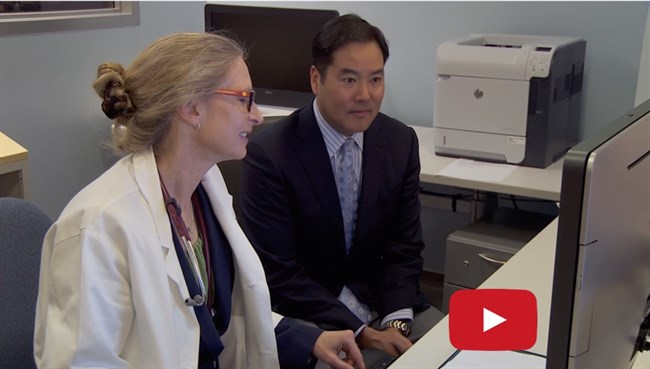Ray Martz
Eric Nakakura and Emily Bergsland Discuss Carcinoid Syndrome Treatment on "Healthy Body, Healthy Mind" Series
Eric Nakakura, M.D., Ph.D., a UCSF gastrointestinal cancer surgeon and Emily Bergsland, M.D.. a UCSF gastrointestinal oncologist, recently discussed the treatment of carcinoid syndrome on "Healthy Body, Healthy Mind", a series hosted by Information Television Network (ITV), a PBS content affiliate. Dr. Nakakura is an Associate Professor in the UCSF Department of Surgery and Dr. Bergsland a Professor in the UCSF Department of Medicine.
The ITV episode, which portrays the struggles of Ray Martz with carcinoid syndrome, recounts the situation he initially faced - that his condition was inoperable, that he would be on a liquid diet indefinitely, and that "nothing further could be done". Unwilling to accept that outcome, Mr. Martz sought treatment at UCSF Medical Center in the the GI Oncology Program, a multidisciplinary team of specialists with extensive experience in diagnosing and treating carcinoid syndrome.
Carcinoid syndrome occurs when a carcinoid tumor, a rare cancerous tumor, secretes an excess of hormones into the bloodstream, causing a variety of debilitating symptoms. Carcinoid tumors are a type of neuroendocrine tumor, formed from neuroendocrine cells, cells which have characteristics of both a nerve cell and a hormone-making cell. The hormones made by gastrointestinal carcinoid tumors are usually destroyed by liver enzymes in the blood. However, if the tumor has spread to the liver, and liver enzymes can no longer destroy the excess hormones, the latter accumulate in the body causing carcinoid syndrome with its significant and debilitating side effects.
Dr. Nakakura described a common etiology in carcinoid syndrome, where the tumor spreads from the ileum, the last third of the small intestine, to the lymph nodes and then to the liver. Patients may then present with abdominal pain and a bowel obstruction (intestinal blockage) caused by the tumor. He characterized the diagnosis as "a major challenge", often taking years to make, because the disease is rare, and because its hallmark symptoms, diarrhea and flushing, which are germane to the diagnosis, are often missed as a telltale sign of carcinoid syndrome.
Cancer surgeon Eric Nakakura, M.D., Ph.D. and medical oncologist Emily Bergsland, M.D. discussing carcinoid syndrome
Dr. Nakakura performed two surgeries on Mr. Martz, the first to treat his intestinal blockage, and the second to remove metastatic carcinoid tumors in his liver (liver metastases). Dr. Bergsland told ITV that one of the goals of the second surgery was to debulk Mr. Martz's liver disease, reduce his tumor burden, and set the back the clock in the disease process. She also discussed the challenges of living with both the side effects of the tumor such as abdominal pain as well as a the hormone-mediated side effects of carcinoid syndrome including diarrhea and flushing. The message was that with proper diagnosis and treatment, neuroendocrine tumor could be managed as a chronic, slowly progressing disease.
